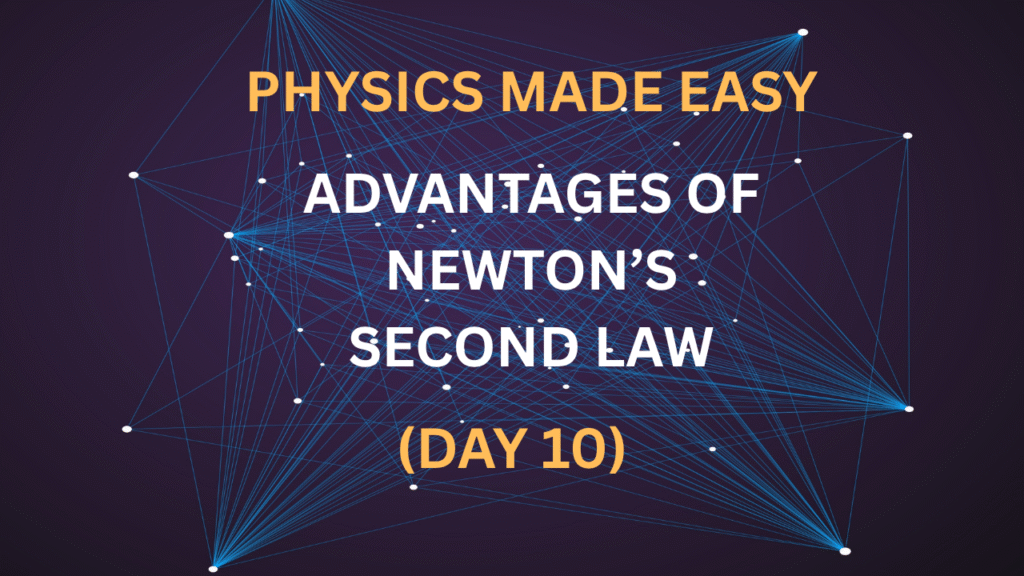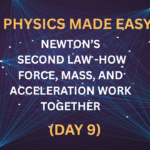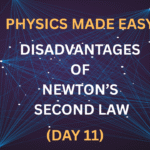Why is Newton’s Second Law Useful?
Newton’s Second Law — F=ma — isn’t just a neat formula; it’s a powerful tool that lets us understand, predict, and control how things move. After exploring Newton’s Second Law of Motion Explained, its real-life examples, deriving the formula, and the force mass acceleration relationship, let’s look at some practical advantages of Newton’s Second Law as part of our Physics Made Easy series.
Exploring the Practical Advantages of Newton’s Second Law



1.Helps Us Calculate Motion Precisely
One of the prime advantages of Newton’s Second Law is its ability to help us calculate exactly how an object will move under different forces and masses.
Example: Engineers use this law extensively when designing cars, machines, and airplanes. By knowing the desired acceleration, they can precisely figure out how much force is needed from an engine, or how much braking force is required—making travel safer and more efficient.
2.Useful in Sports Performance Optimization
Athletes and coaches directly apply this law to optimize performance and gain a competitive edge.This is another one of the major advantages of Newton’s Second Law.
Example: In cricket, a batsman who hits the ball harder (applies more force) will impart greater acceleration, causing it to travel farther and faster. Similarly, a runner trains to apply more force to the ground to achieve greater acceleration. This is Newton’s Second Law in action in sports explore sports science.
3.Explains Accidents and Enhances Safety
The safety advantages of Newton’s Second Law are paramount in the design of protective systems. The law helps us understand the forces involved in impacts.
Example: A large truck moving at high speed has considerable mass and momentum. In a sudden stop or crash, the resulting force (F=ma) will be huge. Safety features like seat belts, airbags, and crumple zones are engineered based on this law to increase the time over which the force is applied, thereby reducing acceleration and the peak force on passengers, protecting them from severe injury understand automotive safety standards.
4.Guides Robust Engineering Design
From the simplest levers to complex robotics, any machine designed to lift, move, or manipulate objects fundamentally relies on this law for stable and efficient operation.This is a key benefit and one of the practical advantages of Newton’s Second Law.
Example: Designing an elevator requires knowing the maximum load’s weight (mass) and its desired upward or downward acceleration. Newton’s Second Law precisely tells engineers how much force is needed from the motor and cables to safely achieve that motion, ensuring the system can handle its intended purpose.
5.Essential for Space Missions
Among the most impressive advantages of Newton’s Second Law is its foundational role in space missions. Rocket scientists use this law to precisely calculate every aspect of space travel.
Example: When agencies like NASA or ISRO launch rockets, they carefully calculate the immense thrust (force) needed from the engines to overcome the rocket’s massive weight and accelerate it sufficiently to escape Earth’s gravity and reach orbit. Every trajectory, every burn, is powered by the principles of Newton’s Second Law learn about NASA rocket propulsion.
Summary
Newton’s Second Law of Motion is so much more than a physics formula. Its advantages touch every part of our world — from sports to space, safety to engineering. By understanding this law, we gain the power to make accurate predictions and smart designs for real-world challenges, highlighting the numerous benefits of Newton’s Second Law in shaping our modern world.
Ready to Explore More?
Next time you see a vehicle speeding up, a rocket launching, or a cricketer hitting a six, remember that Newton’s Second Law is at work. Drop a comment telling us which example surprised you most — and don’t forget to check out our next article on Newton’s Third Law of Motion!
Stay curious. Stay scientific.



